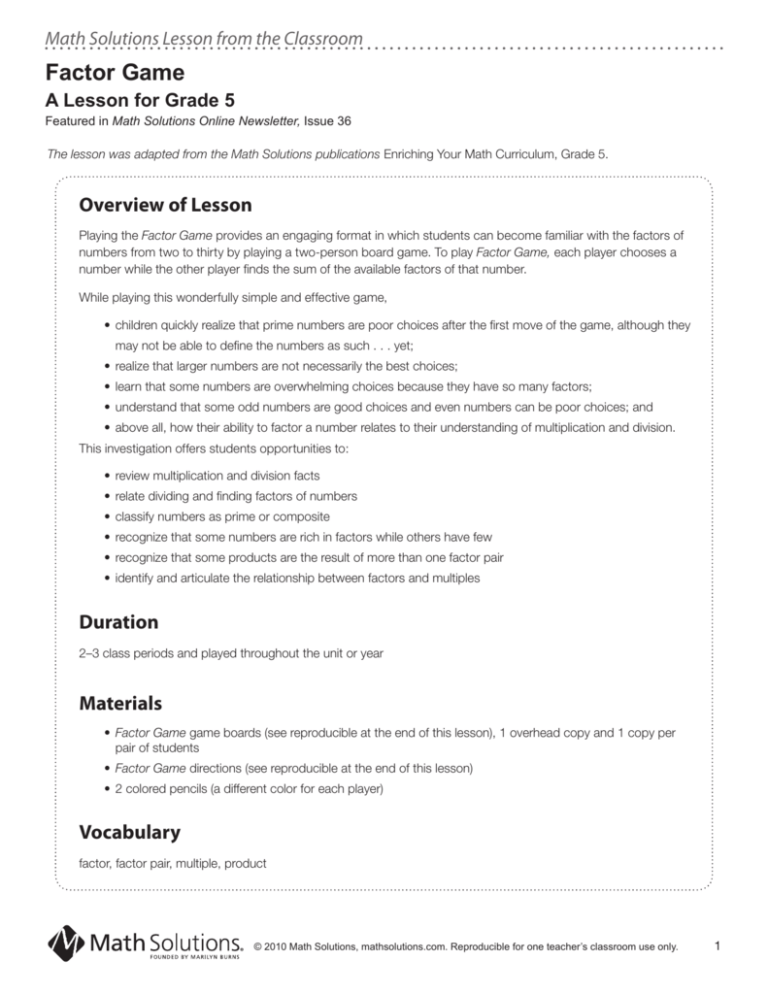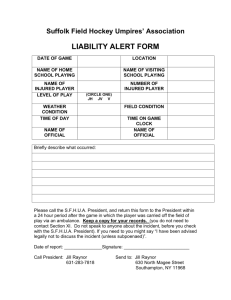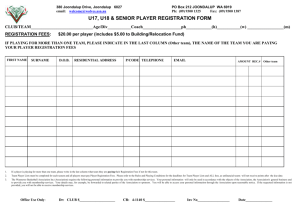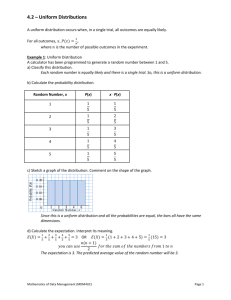Factor Game - Math Solutions
advertisement

Math Solutions Lesson from the Classroom Factor Game A Lesson for Grade 5 Featured in Math Solutions Online Newsletter, Issue 36 The lesson was adapted from the Math Solutions publications Enriching Your Math Curriculum, Grade 5. Overview of Lesson Playing the Factor Game provides an engaging format in which students can become familiar with the factors of numbers from two to thirty by playing a two-person board game. To play Factor Game, each player chooses a number while the other player finds the sum of the available factors of that number. While playing this wonderfully simple and effective game, • children quickly realize that prime numbers are poor choices after the first move of the game, although they may not be able to define the numbers as such . . . yet; • realize that larger numbers are not necessarily the best choices; • learn that some numbers are overwhelming choices because they have so many factors; • understand that some odd numbers are good choices and even numbers can be poor choices; and • above all, how their ability to factor a number relates to their understanding of multiplication and division. This investigation offers students opportunities to: • review multiplication and division facts • relate dividing and finding factors of numbers • classify numbers as prime or composite • recognize that some numbers are rich in factors while others have few • recognize that some products are the result of more than one factor pair • identify and articulate the relationship between factors and multiples Duration 2–3 class periods and played throughout the unit or year Materials • Factor Game game boards (see reproducible at the end of this lesson), 1 overhead copy and 1 copy per pair of students • Factor Game directions (see reproducible at the end of this lesson) • 2 colored pencils (a different color for each player) Vocabulary factor, factor pair, multiple, product © 2010 Math Solutions, mathsolutions.com. Reproducible for one teacher’s classroom use only. 1 Factor Game, Grade 5, continued Lesson Outline Focus or Warm-Up 1. My method of introducing the Factor Game to my class is not standard. Many texts suggest that you discuss the term factor and how it relates to this game. Although this works, I wondered if the children could identify the relationships between the numbers chosen and the points scored without telling them the objective of the game, which would allow them to identify the game’s purpose. I purposefully introduced the game on the overhead with no instructions other than we would be keeping score and the team with the most points would “win.” (The actual instructions are referenced in the reproducibles following this lesson for your preparation.) The title of the game board was available to the children, but they paid no attention to it. 2. I constructed a T-chart on the board to keep track of the points scored. Mrs. S. Fifth Graders 29 1 Introduction 3. I told the children that I would go first . . . after all, I was the teacher! I told them that I was choosing 29 and earned those 29 points. I crossed 29 off on the game board. The, I told them that they would receive 1 point as the result of my choice and crossed off 1. Now it was their turn to choose. 4. The class worked together to choose a number—and invariably chose 30. After all, it was the largest number on the board! I crossed off 30 and posted it on their side of the T-chart while keeping a running total. The class now had 31 points. I deliberately thought out loud as I calculated my points. “Let’s see—I get six and five, two and fifteen, oh yeah, and three and ten. That gives me a total of forty-one points!” Tortured cries were heard from the class. As I was thinking out loud, the children were buzzing about how I was earning my points—and how they were losing theirs! 5. I then chose 25—knowing that the children had to earn points for at least one factor in order for the move to be “legal.” So I posted 25 and asked the class for their choice. Animated mathematical conversation erupted. Some children were aware of some of the rules of the game at this point. They realized that when one player chose a number, the other player earned points related to the numbers multiplied together to get that particular number. The language of factors, multiples, and products was not yet being used, but that was fine at this point in the game. When I first began to play the game in this manner, I was astounded at the inefficiency of the discussion accompanying the game without the availability of this terminology. What a great lesson to learn about the power of mathematical language! 6. As we played one or two more rounds, I began to share a few of the rules—the first being that when you choose a number, the other player must be able to earn points. If the other player can earn no points from your choice, you lose your turn. The language of prime and composite had not yet been introduced, but the children quickly learned that they needed to stay away from prime numbers after that first move because they could not earn any points on the resulting move. © 2010 Math Solutions, mathsolutions.com. Reproducible for one teacher’s classroom use only. 2 Factor Game, Grade 5, continued 7. After several rounds, I introduced language that would be helpful as the children discussed potential moves. As words were discussed, I wrote them on the board for accessibility. The class was familiar with the term product, but not at ease with its application in their casual mathematical conversations. Walk-by interventions, as I call them, are crucial early in the school year. If I hear children playing and referring to “answers” in multiplication problems, a hand on the shoulder and a reminder to use the work product helps to focus the mathematical conversation, making it more efficient and concise. The game title identified the new term factor and its meaning in reference to the game being played. You can also introduce multiple, but be prepared for its misuse. Because of the newness of the language, many fifth graders will interchange factor and multiple. They will often use factor correctly in isolation, but run into difficulty when asked to construct a sentence with both factor and multiple. Please refer to the “Reading, Writing, and Vocabulary” section of Chapter 2 in Enriching Your Math Curriculum, Grade 5 for further discussion of the scaffolding for appropriate use of these terms. An entire class period was devoted to this introduction of the Factor Game. I was delighted with the mathematical observations, insights, and discussions that occurred within this format. The language of factors, multiples, and products was immediately meaningful because it supported the children as they discussed and analyzed their number choices. They also learned an important lesson about the importance of implementing appropriate mathematical language. Kira reminded us several times that it was just plain easier to use the word product than the phrase “. . . the answer to a multiplication problem.” Exploration 8. Once the initial games are played, the children can set off with partners to play a game or two on their own. As the children play the game, circulate through the room, making note of interesting strategies. You may also want to note who continues to struggle with the recall of their basic multiplication facts. A lack of fluency with the multiplication tables can make playing this game difficult and tedious. As you move around the room, you may wish to visit some of the pairs and ask them the following questions: • Is it better to have the first move when you start the game? Why? • What is the best first move? Why? • What is the worst first move? • How do you know when the game is over? • How do you know when you have found all the factors of a number? Summary 9. Pulling the class together for a processing session is important and necessary after the children have had the opportunity to play several rounds of the game. Processing the game gives mathematical meaning to the activity. The children need to realize that although games can be great fun, as this one certainly is, good mathematical games also have purpose. Crafting, asking, and answering good questions can further the mathematical understanding of just about any activity. Good questions can set the stage for meaningful classroom discussion and learning. Students are no longer passive receivers of information when they asked questions that deepen and challenge their mathematical understandings and convictions. Good questions © 2010 Math Solutions, mathsolutions.com. Reproducible for one teacher’s classroom use only. 3 Factor Game, Grade 5, continued •help students to make sense of the mathematics; •are open-ended, whether in answer or approach; •empower students to unravel their misconceptions; •not only require the application of facts and procedures, but encourage children to make connections and generalizations •are accessible to all students in their language; •lead children to wonder more about a topic. (Good Questions, Schuster and Canavan Anderson 2006) Questions such as those that follow can help to scaffold and articulate new understandings that have come about as a result of playing the Factor Game. Processing questions in a whole-class format also gives you the opportunity to implement talk moves. Asking the children to restate classmates’ ideas or strategies can help to keep them focused on the mathematics of the game, while asking children to add on to others’ ideas can deepen insights and observations. You can help to establish respectful discourse by asking for agreement or disagreement. Revoicing can emphasize important mathematics, insights, or strategies. • Is it better to go first or second? Why? • What is the best first move? • What is the worst first move? Why? • How do you know when you have found all the factors of a number? • How do you know when the game is over? • Is there a way to finish the game with all the numbers circled on the game board? • What was your strategy for choosing numbers? • After the first round, what types of numbers did you stay away from? Why? Follow-Up Lessons You can have follow-up lessons that draw upon the understandings constructed from the Factor Game. Lessons exploring prime and composite numbers, odd and even numbers, and square numbers take on greater meaning because of the children’s exposure to and application of these concepts while playing the Factor Game. My class explores perfect, abundant, and deficient numbers as well because of the connections they can make to number choices on the Factor Game game board. Exploring and applying divisibility rules also now have a place and purpose in the curriculum. Being mathematically proficient goes far beyond being able to compute accurately and proficiently. It involves understanding and applying various relationships, properties, and procedures associated with number concepts (Math Matters, Chapin and Johnson 2006). The Factor Game and the lessons that it subsequently supports can do just that. Find more classroom lessons online at mathsolutions.com. Visit the “Educator Tools” section and click on “Free Classroom Lessons.” © 2010 Math Solutions, mathsolutions.com. Reproducible for one teacher’s classroom use only. 4 Reproducible The Factor Game Directions You need: • a partner • colored pencils in two different colors • The Factor Game game board for 30 (see the next reproducible) Directions 1. Player A chooses a number on the game board and circles it. This will be Partner A’s score for that round. 2. Using a different color, Partner B circles all the proper factors of Player A’s number. The proper factors of a number are all the factors of that number except the number itself. Partner B lists the factors. The sum of those factors is Partner B’s score for that round. 3. Player B then circles a new number. Player A circles all the remaining factors of that number. Then, play continues in this manner. 4. The players take turns choosing numbers and circling factors. 5. If a player circles a number that has no factors left which have not been circled, then that player does not get points for the number circles and loses his or her turn. 6. The game ends when there are no more numbers left with uncircled factors. 7. The player with the larger sum of factors and products is the winner. Extension: Play a game on a 49 game board! (See the corresponding reproducible.) The Factor Game is referenced in various publications: • About Teaching Mathematics (Burns 2007) • Prime Time (Connected Mathematics 2) (Lappan, Fey, Fitzgerald, Friel, and Phillips 2006) A similar game called Factor Captor is referenced in: Everyday Mathematics: The University of Chicago School Mathematics Project, Grade 5 (Everyday Learning Corporation 2002). Reproducible The Factor Game Game Board for 30 1 2 3 4 5 6 7 8 9 10 11 12 13 14 15 16 17 18 19 20 21 22 23 24 25 26 27 28 29 30 1 2 3 4 5 6 7 8 9 10 11 12 13 14 15 16 17 18 19 20 21 22 23 24 25 26 27 28 29 30 Reproducible The Factor Game Game Board for 49 1 2 3 4 5 6 7 8 9 10 11 12 13 14 15 16 17 18 19 20 21 22 23 24 25 26 27 28 29 30 31 32 33 34 35 36 37 38 39 40 41 42 43 44 45 46 47 48 49








